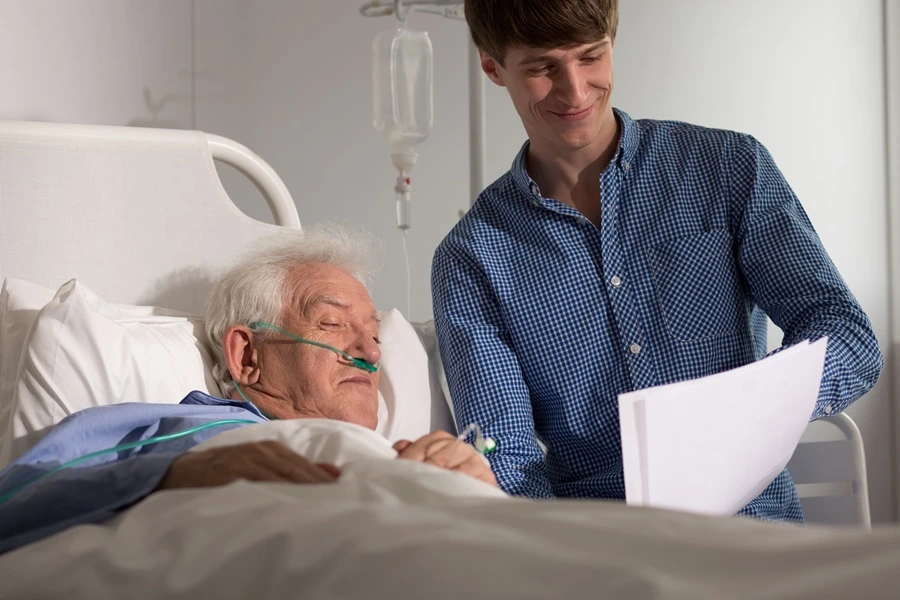When families reach the point of considering hospice care, they deserve honest information and steady support. Hospice can take place in more than one setting — while it sometimes occurs in the home, it can also call for a short stay in an inpatient unit when symptoms become too difficult to manage there.
APEX Health Services provides compassionate home hospice services, working closely with patients and families to make each setting feel connected. We focus on comfort, dignity, and relief for every person in our care.
Each level of hospice care serves a specific purpose, and we’ve outlined what you need to know about this topic to help you be prepared for any kind of situation.
Home Hospice: Comfort in Familiar Surroundings
Home hospice, such as our outpatient hospice care, keeps loved ones close and daily routines intact, while professional care comes directly to the patient. Whether someone lives in a house, apartment, or assisted living community, the hospice team brings medical skill and emotional support to that familiar space.
Hospice Services Delivered at Home
At-home hospice care encompasses far more than occasional visits. Families receive:
- Regular visits from registered nurses monitoring symptoms and adjusting care plans.
- Hospice aide assistance with personal care.
- Medication management that ensures pain relief and symptom control.
- Medical equipment delivery, including hospital beds and oxygen.
- On-call support available 24/7 for urgent concerns.
- Emotional support and spiritual guidance for the whole family.
The frequency of visits adjusts to match changing needs, often intensifying as the end-of-life journey progresses.

Financial Considerations of Home Hospice Care
Medicare Part A fully covers home hospice care, as do most private insurance plans. Coverage includes nursing visits, medications related to the hospice diagnosis, equipment, and supplies. Families are rarely responsible for out-of-pocket costs beyond personal items or medications unrelated to the primary illness.
For those who temporarily need extra support, short-term respite care is also included in the hospice benefit, offering a few days of relief for family caregivers.
Determining If Home Hospice Is Suitable
Home hospice works well when:
- A caregiver or family member can be present much of the time.
- The home environment allows for safe and comfortable care.
- Symptoms are manageable with regular visits and on-call support.
- The patient wishes to remain in their familiar surroundings.
With experienced hospice guidance, many families find they can provide remarkable comfort and peace at home, especially when they’re supported by a team that stands beside them every step of the way.

Inpatient Hospice Care: Short-Term Support for Complex Symptoms
Sometimes, a patient’s symptoms can suddenly intensify — pain, breathing distress, or agitation that can’t be eased at home. In these moments, hospice care may shift temporarily to an inpatient setting for round-the-clock medical attention.
This level of care is designed for short-term stabilization, usually lasting only a few days, until symptoms are brought under control. As soon as the patient is comfortable again, care continues in the home setting.
What Inpatient Facilities Provide
Inpatient hospice care offers the same compassionate approach as home hospice, with additional medical support available around the clock.
Patients in the inpatient unit receive:
- Continuous nursing care and immediate response to changing conditions.
- Specialized pain and symptom management that requires frequent adjustments.
- Access to medical equipment and medication delivery that can’t be used safely at home.
- Emotional and spiritual support for both patient and family.
- Respite care for exhausted family members who need recovery time.
This level of care gives families peace of mind, knowing their loved one is comfortable and closely monitored until symptoms settle.
When Inpatient Care Is Appropriate
Inpatient hospice is reserved for situations that require intensive medical management, such as:
- Severe or unrelieved pain
- Respiratory distress
- Uncontrolled nausea, vomiting, or seizures
- Agitation or restlessness that can’t be calmed at home
These admissions are short-term by design, typically seven days or fewer, and are reviewed regularly to ensure they are medically necessary.

Payment Options for Inpatient Care
Inpatient hospice and respite stays are part of the standard hospice benefit under Medicare and most insurance plans. These stays are covered when medical criteria are met, so families can focus fully on comfort and connection rather than logistics.
Important Distinction: Inpatient Hospice vs. Skilled Nursing Facilities
It's crucial not to confuse inpatient hospice units with skilled nursing facilities that provide hospice care. While both offer 24-hour care, they serve very different purposes:
Inpatient hospice units (IPU):
- Strictly for acute medical crises requiring intensive symptom management.
- Limited to 7 days or less.
- Admission is based solely on unmanageable medical symptoms.
- Temporary crisis intervention, not long-term residence.
Skilled nursing facilities with hospice:
- For patients who cannot remain at home due to a lack of family caregivers or unsafe living conditions.
- No strict time limits on stays.
- Provides ongoing residential care with hospice services.
- Admission based on social/environmental factors, not just a medical crisis.
If you're seeking care because no family member can provide round-the-clock support or your home environment isn't suitable for care, a skilled nursing facility, not an inpatient hospice unit, would be the appropriate choice.
How Home and Inpatient Hospice Work Together
Hospice care adapts to each patient’s changing needs. Hospice care often takes place at home — where comfort, connection, and routine bring peace. When symptoms suddenly become too difficult to manage, care can shift briefly to the inpatient unit for intensive support.
These two settings aren’t separate choices but connected parts of the same care journey. Together, they ensure every patient receives the right level of attention at every stage.
Both home and inpatient hospice care share the same purpose of providing comfort, dignity, and peace. The difference lies in the level of medical attention needed at a given moment. We’ve put together an outline below that shows how these two settings work together within the same plan of care, shifting smoothly as a patient’s needs change:
When Hospice Care Needs Change
Hospice care is meant to follow the patient and adapt as comfort needs rise and fall. When symptoms suddenly worsen, a short inpatient stay can provide the intensive support needed to restore stability and peace.
Families often see these transitions as part of the natural flow of care, not as separate decisions. Some of the most common reasons for a temporary move to inpatient care include:
- Severe or unrelieved symptoms that can’t be managed safely at home.
- Frequent medication adjustments or medical monitoring.
- Short-term caregiver relief through respite care.
- Safety concerns that temporarily make home care difficult.
- Emotional exhaustion in families who need a brief rest before resuming home caregiving.
Once symptoms are controlled, the patient typically returns home and is supported by the same hospice team. This fluid approach ensures care remains centered on comfort, not location, helping families feel supported every step of the way.
FAQ
Your Hospice Journey Starts with One Call
Every family deserves hospice care that feels steady, personal, and connected. We understand that this is a challenging and emotionally difficult time, and our team is here to help you navigate the ups and downs.
APEX Health Services honors each family's unique needs, providing exceptional home hospice care throughout Chicago. Contact us today, and we’ll listen, answer questions, and help you find the right level of care for your loved one — always leading with compassion and respect.

.svg)
.webp)


